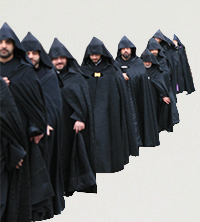
In the late 19th and early 20th centuries, the Catholic Church was target of sharp criticism, the main points of which were social and national issues. If, for example, in Italy and Germany the church was regarded as an ultranational structure that hindered the reunification of these countries, then in parallel with the spread of labor movements and socialist doctrine, it began to be perceived as a tool of exploitative class. The Catholic Church made great efforts to change the situation and develop new social and political concepts in the church.
The Armenian Church has approximately appeared in such a situation. The main axis of the public discourse in the country’s political and social life is conversations on injustice, electoral frauds, social injustice, distrust of the judiciary and justice in general, and so on. Under these conditions, the church elite has begun to be viewed as a public servant of an illegitimate system in the public discourse.
Some high-ranking clerics are among the main heroes of corruption scandals((Հայ առաքելական եկեղեցին կդիմի՞ դատարան: Նյութի աղբյուրը ` hraparak.am, http://hraparak.am/?p=72867&l=am%2Fhay+araqelakan+ekexecin+kdimi+dataran)), who appear in the center of criticism, nevertheless continue to hold office. It also contributes to the fact that the church budget is closed to its followers, which is why there is public distrust towards the church elite. The church receives tax privileges from the state and has already become a large taxpayer((«Հայոց Աշխարհ», 27 հունիսի 2009 #121/292127)) and owner of material wealth, but the fact that the church budget and financial activity are not transparent, in its turn, is a rich subsidy for public doubts.
The other most important issue is the attitude towards religious freedom. One of the fundamental provisions of the Armenian constitution and legislation is the principle of freedom of conscience, but in the public rhetoric of the clergy this principle is criticized. Moreover, religious freedoms are condemned and presented as an anti-national provision that creates a serious problem in public perceptions of constitutionalism and legitimacy. Openly speaking against religious freedoms, the Church tries to expel other religious organizations from the law, qualifying them as “sect” and anti-national structures.
The conservative leader of the Shirak Diocese, his eminence Mikayel Ajapahyan, made a remarkable statement. “The mission must be carried out by everyone in the flock, not in the flock of others, or should be carried out where there is no religion, in a state of indifference …The propaganda of faith in any other confessional community is proselytizing, this is a simple thing that any clergy who wants to be from the Apostolic church, Catholic or Evangelical, understands, and does not want to confuse others in this sense “((Можно ли называть еретиками и монофизитами Армянскую Апостольскую Церковь?, Radio Vatikan, 13/06/2016, ru.radiovaticana.va)). In fact, the Armenian Church accepts the other churches, but not in the Armenian ethnic sphere.
One of the main issues is the identification of national and religious belonging, one of the molds of the Miletian past, and the main thesis of the Armenian Church propaganda. In the final part of this brief article, we will try to briefly formulate the main issues that should be addressed by the Armenian Church in a timely manner to solve the accumulated issues. This is not only necessary for the church, but also is the imperative of the Armenian statehood.
They are as follows:
a) refuse the national and religious identification provisions; b) formulate the official attitude of the church on the right to religious freedom that complies with the Constitution of Armenia and the international obligations assumed by Armenia; c) start a dialogue with other Armenian communities of other religions, tribes and conventions to form an atmosphere of inter-national solidarity and mutual assistance; d) prepare its social conception clearly expressing the Church’s viewpoints on social justice, property rights, family, lone mothers and other key issues of the public agenda; e) establish the rules of church-state cooperation; f) publish and present to his followers the church budget, annual expenses, listings of property and assets, business entities, church bank accounts and donations reports.
Certainly, it is difficult to present the whole spectrum of grave problems of the church in such a brief article, including the problem of clarifying the authenticity of the formalities, the first historical step taken towards it in 1996, on December 13, when Catholicos of All Armenians Garegin II signed a declaration on common belief in Jesus Christ with John Paul II in Vatican.
Theologians often call Christianity a living belief that is able to respond to the challenges of time under new realities. Unfortunately, in the rhetoric of the Armenian Apostolic Church, they always try to return to the past patterns, and the need for transformation is not noticeable in their public speeches.